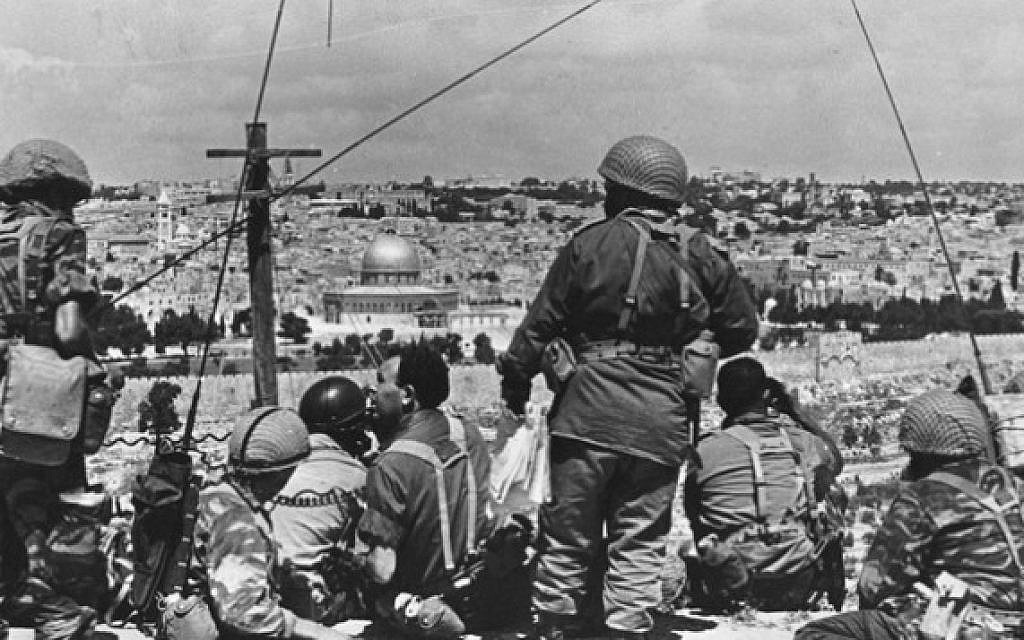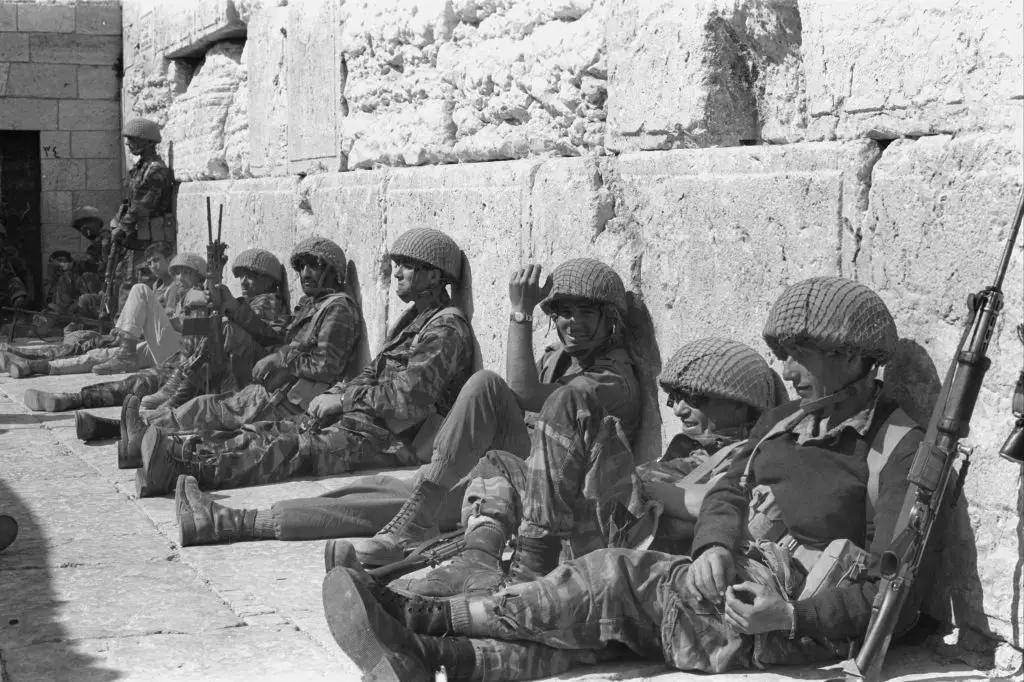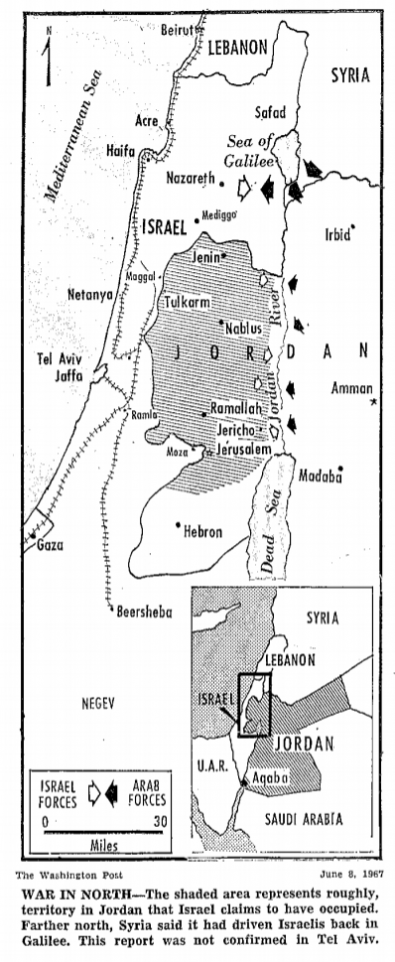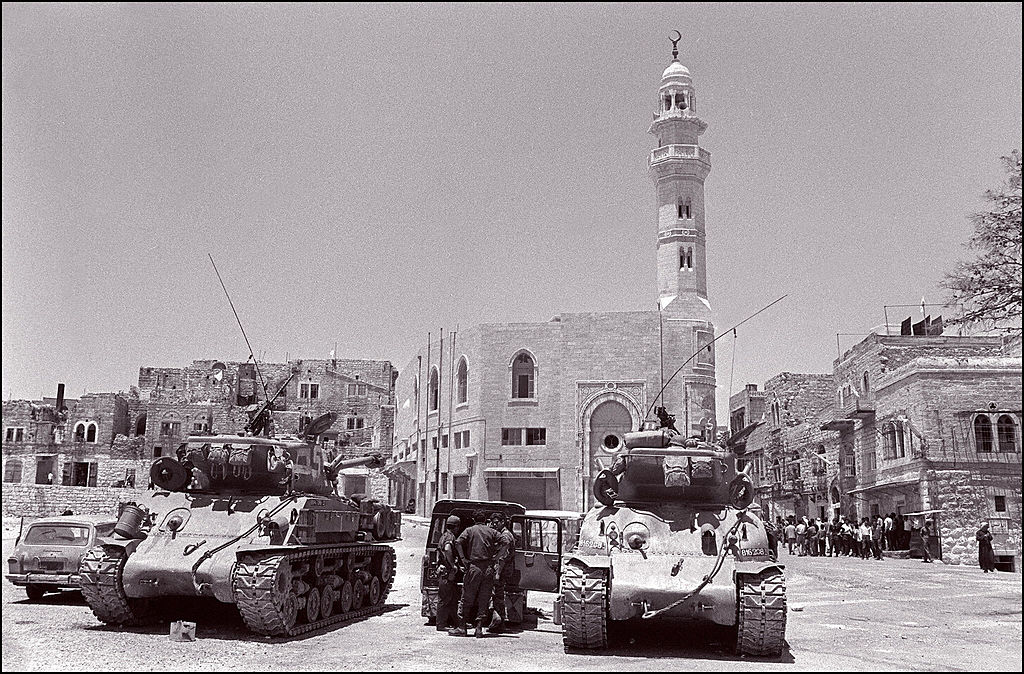lordroel
Administrator
Posts: 67,964 
Likes: 49,369
|
Post by lordroel on Jun 1, 2019 11:20:31 GMT
Six-Day War in real time This war in real time is about the Six-Day War (Hebrew: מִלְחֶמֶת שֵׁשֶׁת הַיָּמִים, Milhemet Sheshet Ha Yamim; Arabic: النكسة, an-Naksah, "The Setback" or حرب 1967, Ḥarb 1967, "War of 1967"), also known as the June War, 1967 Arab–Israeli War, or Third Arab–Israeli War, which was fought between June 5th and June 19th 1967 by Israel and the neighboring states of Egypt (known at the time as the United Arab Republic), Jordan, and Syria. Prelude to War, June 1st 1967
Nasser receives former U.S. Treasury Secretary Robert Anderson and agrees to send his second vice president, Zakariya Muhieddin, to Washington to discuss ways to defuse the situation. Facing criticism of his “procrastination,” Eshkol broadens his coalition and names Moshe Dayan, still a war hero from the 1956 war, defense minister. Herut leader Menachem Begin and others are brought into a national unity government and given Cabinet rank without portfolios.
PLO Chairman Ahmed Shukairy, reconciled with Hussein, says in Amman that he expects war, that Jordan might start it and that the Arabs will win. “The Jews in Palestine will have to leave,” he says. “Any of the old Palestinian Jewish population who survive may stay, but it is my impression that none of them will survive.”
Armies
The Israeli army had a total strength, including reservists, of 264,000, though this number could not be sustained, as the reservists were vital to civilian life.
Against Jordan's forces on the West Bank, Israel deployed about 40,000 troops and 200 tanks (eight brigades). Israeli Central Command forces consisted of five brigades. The first two were permanently stationed near Jerusalem and were the Jerusalem Brigade and the mechanized Harel Brigade. Mordechai Gur's 55th Paratroopers Brigade was summoned from the Sinai front. The 10th Armored Brigade was stationed north of the West Bank. The Israeli Northern Command comprised a division of three brigades led by Major General Elad Peled which was stationed in the Jezreel Valley to the north of the West Bank.
Photo: An Israeli armored unit of Centurion tanks mounted with 105 mm guns stand in the Negev, picture taken on May 20th 1967.

On the eve of the war, Egypt massed approximately 100,000 of its 160,000 troops in the Sinai, including all seven of its divisions (four infantry, two armoured and one mechanized), four independent infantry brigades and four independent armoured brigades. Over a third of these soldiers were veterans of Egypt's continuing intervention into the North Yemen Civil War and another third were reservists. These forces had 950 tanks, 1,100 APCs, and more than 1,000 artillery pieces.
Syria's army had a total strength of 75,000 and was deployed along the border with Israel, Since Syria’s army had been decimated in the months and years prior through coups and attempted coups that had resulted in a series of purges, fracturings and uprisings within the armed forces.
The Jordanian Armed Forces included 11 brigades, totalling 55,000 troops. Nine brigades (45,000 troops, 270 tanks, 200 artillery pieces) were deployed in the West Bank, including the elite armoured 40th, and two in the Jordan Valley. They possessed sizable numbers of M113 APCs and were equipped with some 300 modern Western tanks, 250 of which were U.S. M48 Pattons. They also had 12 battalions of artillery, six batteries of 81 mm and 120 mm mortars, a paratrooper battalion trained in the new U.S.-built school and a new battalion of mechanized infantry. The Jordanian Army, then known as the Arab Legion, was a long-term-service, professional army, relatively well-equipped and well-trained. Israeli post-war briefings said that the Jordanian staff acted professionally, but was always left "half a step" behind by the Israeli moves. The small Royal Jordanian Air Force consisted of only 24 British-made Hawker Hunter fighters, six transports, and two helicopters. According to the Israelis, the Hawker Hunter was essentially on par with the French-built Dassault Mirage III – the IAF's best plane.
Photo: Mirage fighter jets train over Israel in 1967 before the Six Day War.

100 Iraqi tanks and an infantry division were readied near the Jordanian border. Two squadrons of Iraqi fighter-aircraft, Hawker Hunters and MiG 21s, were rebased adjacent to the Jordanian border.
Why Did Israel Go To War? | Six Day War Project
|
|
lordroel
Administrator
Posts: 67,964 
Likes: 49,369
|
Post by lordroel on Jun 2, 2019 7:44:05 GMT
Prelude to War, June 2nd 1967
Nasser warns his senior officers that the Israelis will strike in a few days. His warning goes largely unheeded. The UAR newspaper Al-Ahram reports that the Suez Canal will be closed to all ships that try to break the blockade of Aqaba, and Egypt will view such attempts as “acts of aggression.” … The French government announces that it “i s not committed in any way and on any subject” or on the side of “ any of the states involved.” De Gaulle says his country’s policy toward the budding conflict is “ positive neutrality.” In Tel Aviv, 12,000 volunteers, including schoolchildren, join in digging trenches and filling sandbags. Photo: A group of men build shelters in Tel Aviv, June 1967.
 Photo: a AMX-13 tank in the woods, picture taken on May 20th 1967. Photo: a AMX-13 tank in the woods, picture taken on May 20th 1967.
![]()  Egypt Expels UN Observers | Six Day War Project Egypt Expels UN Observers | Six Day War Project
|
|
lordroel
Administrator
Posts: 67,964 
Likes: 49,369
|
Post by lordroel on Jun 3, 2019 3:10:53 GMT
Prelude to War, June 3rd 1967Eshkol’s Cabinet, after hearing Mossad head Meir Amit’s report from Washington, decides to recommend war to the full government the next day. Libyan King Idris orders army units to take up positions with Egyptian forces near Israel. Israel’s ambassador to the United Nations, Gideon Rafael, presents a detailed outline of events leading to the war. Photo: Sharon, commanding officer of the 38th Division meets with his officers, picture taken on May 27th 1967.
 A CIA assessment is summarized with two formidable conclusions, “ the rapidly growing belief in Israel that time is running out and that if Israel is not to suffer an ultimately fatal defeat, it must very soon either strike or obtain absolutely iron-clad security assurances from the West. The second aspect is the rise of a euphoric, band-wagon spirit among the Arab states, leading even moderate Arabs to believe that the time may in fact have come when the Arabs can close in on Israel with some hope of success. The Arabs are sniffing blood.” The New York Times reports that Britain declared the Egyptian blockade could lead to war. They further reported that four Syrian commandos had been intercepted in Israel. Israel’s newly-appointed Defence Minister Moshe Dayan, wishing to confine hostilities if possible to the imminent battles against Egypt, ordered the Israeli Army not to open a second front with Jordan in the West Bank in the event of war. He instructed the head of the Israeli Army Central Command; “ You must not do anything to entangle Israel with the Jordanians...” Photo: A Israeli Air Force (IAF) Mirage IIICJ, a Mystére IVA, a Vautour, a Super Mystére B.2 and an Ouragan, picture taken on June 1st 1967 Johnson presents two U.S. principles: “The first is that we support the territorial integrity and political independence of all of the countries of the Middle East. This principle has now been affirmed by four American presidents. The second is our defense of the basic interest of the entire world community in the freedom of the seas. As a leading maritime nation, we have a vital interest in upholding freedom of the seas, and the right of passage through a strait of an international character. … I must emphasize the necessity for Israel not to make itself responsible for the initiation of hostilities. Israel will not be alone unless it decides to go alone. We cannot imagine that it will make this decision.” Secretary of State Dean Rusk, in writing to Arab ambassadors, warns, “The ‘Holy War’ psychology of the Arab world is matched by an apocalyptic psychology within Israel. Israel may make a decision that it must resort to force to protect its vital interests. In dealing with the issues involved, therefore, we must keep in mind the necessity for finding a solution with which Israel can be restrained.”
Military Build Up
Egypt has 210,000 troops ready for deployment, with 100,000 of them with 930 tanks ready in the Sinai. They have 30 Tu-16 Russian-made bombers, which are a threat to Israel’s cities. Overall the Egyptian Air Force, by far the largest and the most modern of all the Arab air forces, consisting of about 450 combat aircraft, all Soviet-built and relatively new. Syria has 63,000 troops and Jordan has 55,000 – totaling 328,000 troops ready to fight Israel. The Arabs have 2,330 tanks of which more than 1,1000 are operated by the Egyptian Army who has in its inventory, T-34/85s, T-54/55s, and SU-152s compared to the Israeli inventory of 200 upgraded American M50/51 Super Shermans, 200 M48 Pattons, 300 British Centurions and 200 French AMX-13s, thus the Arabs have twice the number of tanks compared to Israel and far more combat aircraft too (682 compared to Israel’s 286); They have 1,845 armored personnel carriers compared to Israel’s 1,500. However, by fully mobilizing Israel can muster 250,000 men. Israel would need to rely on the training and motivation of this largely civilian army to counter the numeric superiority of the Arabs in manpower and weaponry. Egypt Blockades the Straits of Tiran | Six Day War Project
|
|
lordroel
Administrator
Posts: 67,964 
Likes: 49,369
|
Post by lordroel on Jun 4, 2019 3:06:20 GMT
Prelude to War, June 4th 1967
It is announced that Egypt’s Muhieddin will visit Washington and U.S. Vice President Hubert Humphrey will visit Cairo to defuse the crisis. Iraq joins the Egyptian-Jordanian defense pact. Algeria, Libya and Sudan report that they are preparing to send forces to Egypt; Kuwaiti troops are already in Egypt. A conference of 11 Arab oil-exporting countries opens in Damascus at Iraq’s initiative to consider prohibiting the sale of oil to countries that support Israel. The Israeli Cabinet passes a secret resolution: “After hearing a report on the military and political situation from the prime minister, the foreign minister, the defense minister, the chief of staff and the head of military intelligence, the government ascertained that the armies of Egypt, Syria and Jordan are deployed for immediate multifront aggression, threatening the very existence of the state. The government resolves to take military action in order to liberate Israel from the stranglehold of aggression which is progressively being tightened around Israel. The government authorities — the prime minister and the defense minister — will confirm to the General Staff of the IDF the time for action. Members of the Cabinet will receive as soon as possible the information concerning the military operation to be carried out. The government charges the foreign minister with the task of exhausting all possibilities of political action in order to explain Israel’s stand and to obtain the support of the powers.” King Husain of Jordan today warned Britain and the United States that they stood to lose their friends in the Arab world for ever if they fell into the Zionist trap of supporting Israel in the present crisis. Military Build Up
Seven to eight Egyptian division, two of them armored, now deployed in Sinai: 200 tanks opposite Eilat, with the aim of cutting off the Southern Negev. Along Israel's Eastern border: 60,000 Jordanian soldiers and 300 tanks. The Jordanian army placed under Egyptian command units, as well as Iraq forces which had entered its territory. On Israel's Northern border with Syria, 50,000 Syrian soldiers dug in, fortified and protected by concrete and steel. Some 600 Egyptian, Jordanian, Syrian and Iraqi planes ready. Map: Ground force dispositions of the United Arab Republic (Egypt) as of January 1st 1967 prepared by Defense Intelligence Agency (DIAAP). Photo: Gamal Abdel Nasser with pilots at a Sinai airbase along the border with Israel prior to the Six Day War Photo: Gamal Abdel Nasser with pilots at a Sinai airbase along the border with Israel prior to the Six Day War What Made This a 'War of No Choice' | Six Day War Project What Made This a 'War of No Choice' | Six Day War Project
|
|
lordroel
Administrator
Posts: 67,964 
Likes: 49,369
|
Post by lordroel on Jun 5, 2019 3:16:54 GMT
Day 1 of Six-Day War, June 5th 1967
Newspapper: Chicago Tribune
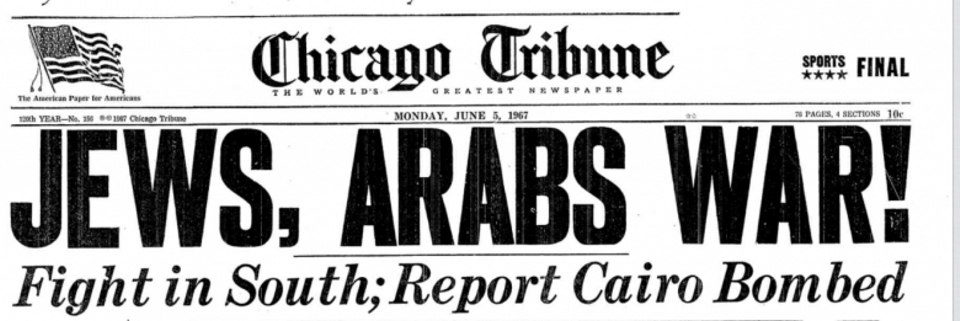 At 7:15, the call was sounded: The IAF Commander, Major General Motti Hod, announced the beginning of Operation Focus (Hebrew: מבצע מוקד, Mivtza Moked). IAF aerially attacked the Egyptian Air Force, attacking plane after plane eventually destroying the Suchi, Mig, Alishon and Tupolg aircrafts. The Egyptian Air Force runway was severely destroyed as well. The IAF attack resulted in the destruction of 197 Egyptian aircrafts and 11 airports, in a manner of minutes. Six airports and eight radar stations were taken out of action as well. At 09:34, a second wave of attacks began in which 107 grounded Egyptian planes were bombed. At 15:00 hours, after Israel was already awash with rumors of the Egyptian Air Force defeat, Defense Minister Moshe Dayan called for a press conference. He warned the press not to publish the amount of Arabic planes Israel destroyed, which numbered over 400 hundred. At 02:00 hours, the Chief of General Staff, Lieutenant General Yitzchak Rabin broadcasted from nationwide radio: 400 enemy planes were destroyed. Major General Hod broadcasted that the IAF had lost 19 pilots. Photo: the shadow of an Israeli Mirage III is clearly seen as it overflies 3 destroyed Egyptian Mig 21s.
 Drawing: Israeli Mirage III attacking Egyptian MiG 15s. Drawing: Israeli Mirage III attacking Egyptian MiG 15s.
 Israel’s entry into the West Bank is not a premeditated Israeli plan for territorial expansion. Instead, at 10:40 a.m., Dayan says in a message to the troops; “ We have no aims of conquest. Our only aim is to frustrate the attempt of the Arab armies to conquer our country and to sever and crush the ring of blockade and aggression which has been created around us.” An hour later Eshkol broadcasts to the nation; “ We shall not attack any state so long as it does not wage war against us. But anyone attacking us will meet with our full power of self-defense and our capacity to defeat his forces.” Israel gives assurances to Jordan that morning that there will be no attack if Jordan does not open hostilities. Nevertheless, Jordanian forces open fire on Jewish Jerusalem at 11:45 a.m. and expel the U.N. observers from their headquarters in the city after King Hussein had received false information from Egypt denying Egyptian losses and claiming a massive and successful Egyptian attack against Israel. Emboldened by this information, Jordan launched immediate multiple attacks on Israel. Fighting rages from Syria to the Sinai and along the Jordanian border. Cairo Radio reports that places in the UAR have been bombed. The Egyptian government says Arab land forces have repulsed invading Israeli armor on the Gaza Strip and in the Sinai. Israel claims major victories in the Sinai and Gaza, saying troops have taken al-’Arish and Khan Yunis. The Israeli government also reports that planes have decimated the Egyptian, Syrian and Jordanian air forces. Photo: Israeli armor advances against Egyptian troops, near Rafah, Gaza Strip
 A two-day meeting of the oil ministers of all Arab oil-producing states ends in Baghdad after agreeing to three resolutions: that oil supplies will be suspended to any state that “agrees or supports an aggression” against any Arab state; that any such aggression would mean that properties of that country’s companies and nationals would be subject to war resolutions; and that all Arab states should hold an emergency meeting to implement the war regulations. The Egyptian armed forces supreme command charges that American and British planes provide fighter cover over Israel during raids by Israeli aircraft. The Johnson administration has done little to fend off war, and the president wants to be careful what the administration says now that war has broken out. But when asked by a reporter if the administration intends to reaffirm its neutrality, State Department spokesman Robert McCloskey says, “Indeed I would; I would be happy to. We have tried to steer an even-handed course through this. Our position is neutral in thought, word and deed.” Joseph Califano, a special assistant to the president, frets that the remarks are “killing us with the Jews in this country.” Senate Minority Leader Everett Dirksen (R-Ill.) ridicules the remarks, saying: “What’s neutral? I call it ‘snootral’ — when you stick up your snoot at both sides.” Map: Conquest of Sinai, June 5th to June 6th.
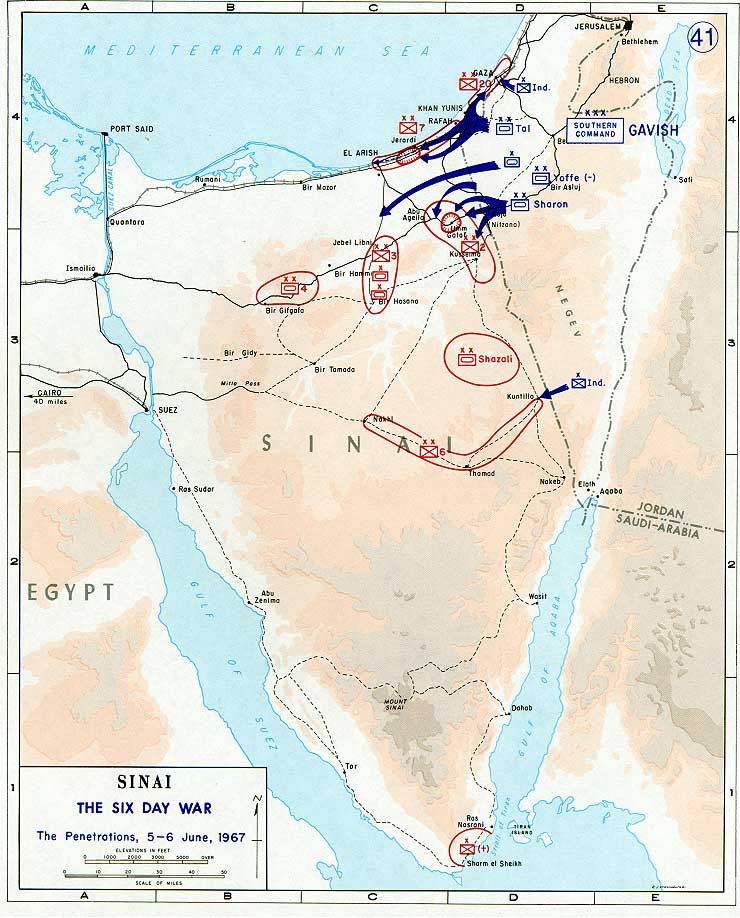 YouTube Day One of the War | Six Day War Project YouTube Day One of the War | Six Day War Project
YouTube British Movietone
|
|
lordroel
Administrator
Posts: 67,964 
Likes: 49,369
|
Post by lordroel on Jun 6, 2019 2:52:40 GMT
Day 2 of Six-Day War, June 6th 1967Newspapper: The Washington Post
 Israeli troops sweep around the Jordanian sector of Jerusalem and reach Mount Scopus. Eshkol appeals to the Soviet Union to help secure peace “based on the independence and territorial integrity of all nations.” In the south, Israeli forces clear Abu Aweigila, advance deep into the Sinai and occupy Gaza. Israel takes further Jordanian strongpoints in and around Jerusalem and captures Ramallah, Jenin, Tulkarm and Kalkilya on the West Bank. The Soviet Union demands that Israel “immediately and unconditionally” halt military operations and asks that the United Nations condemn the Israeli aggression. Egypt charges that U.S.-British air cover has been provided to Israel, explaining why Israel has flown so many more sorties than seems possible based of the number of Israeli aircraft. Rather than take an hour to turn a plane around and refurbish it with armaments and fuel, Israel accomplishes the task in 20 minutes, giving the appearance that its air force is triple its size. Egypt severs diplomatic relations with the United States, not to be resumed until after the October 1973 war. Photo: Israeli Sherman M4 tanks are seen moving towards the Sinai.
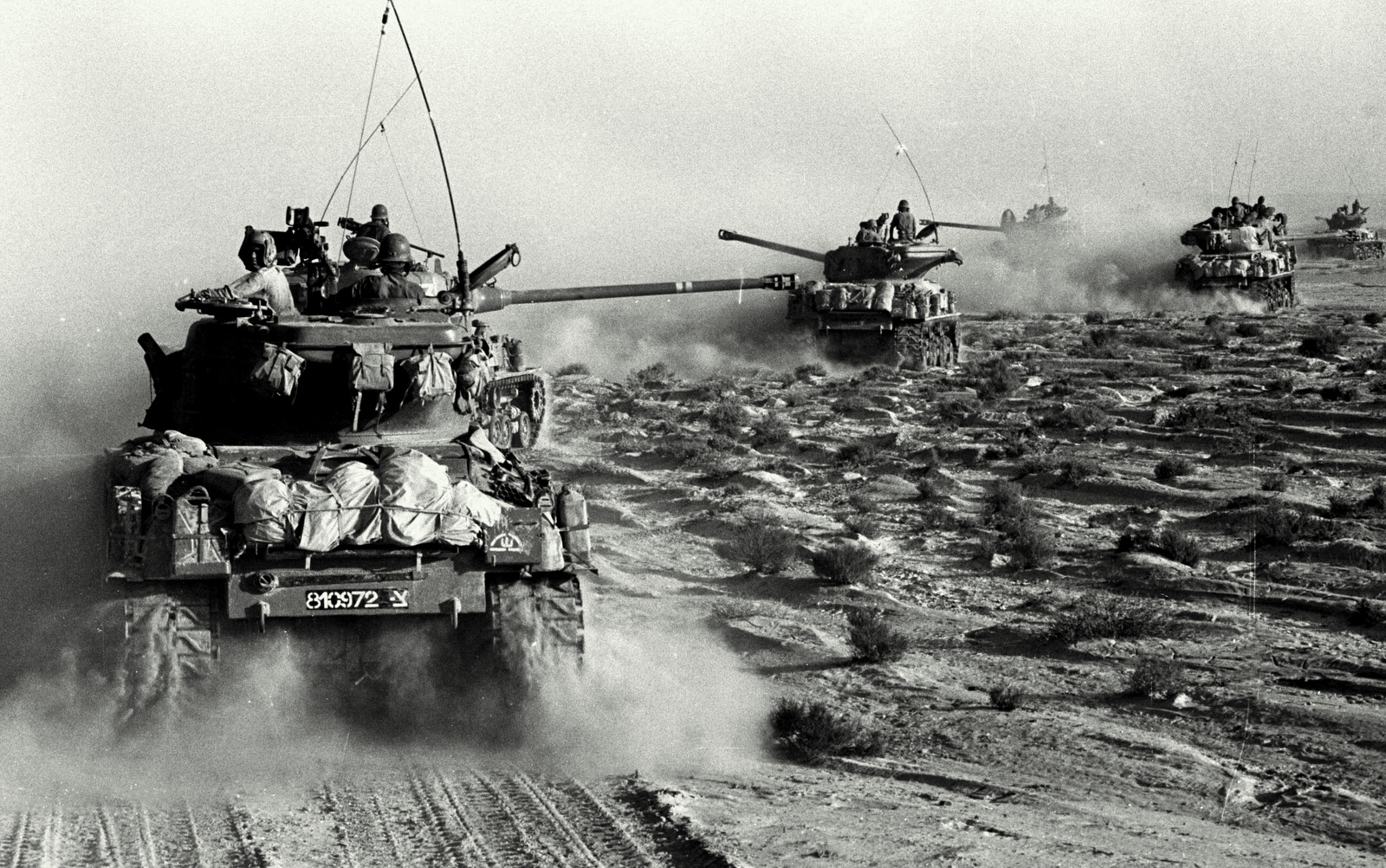
Newspaper: The Guardian, June 6th 1967.
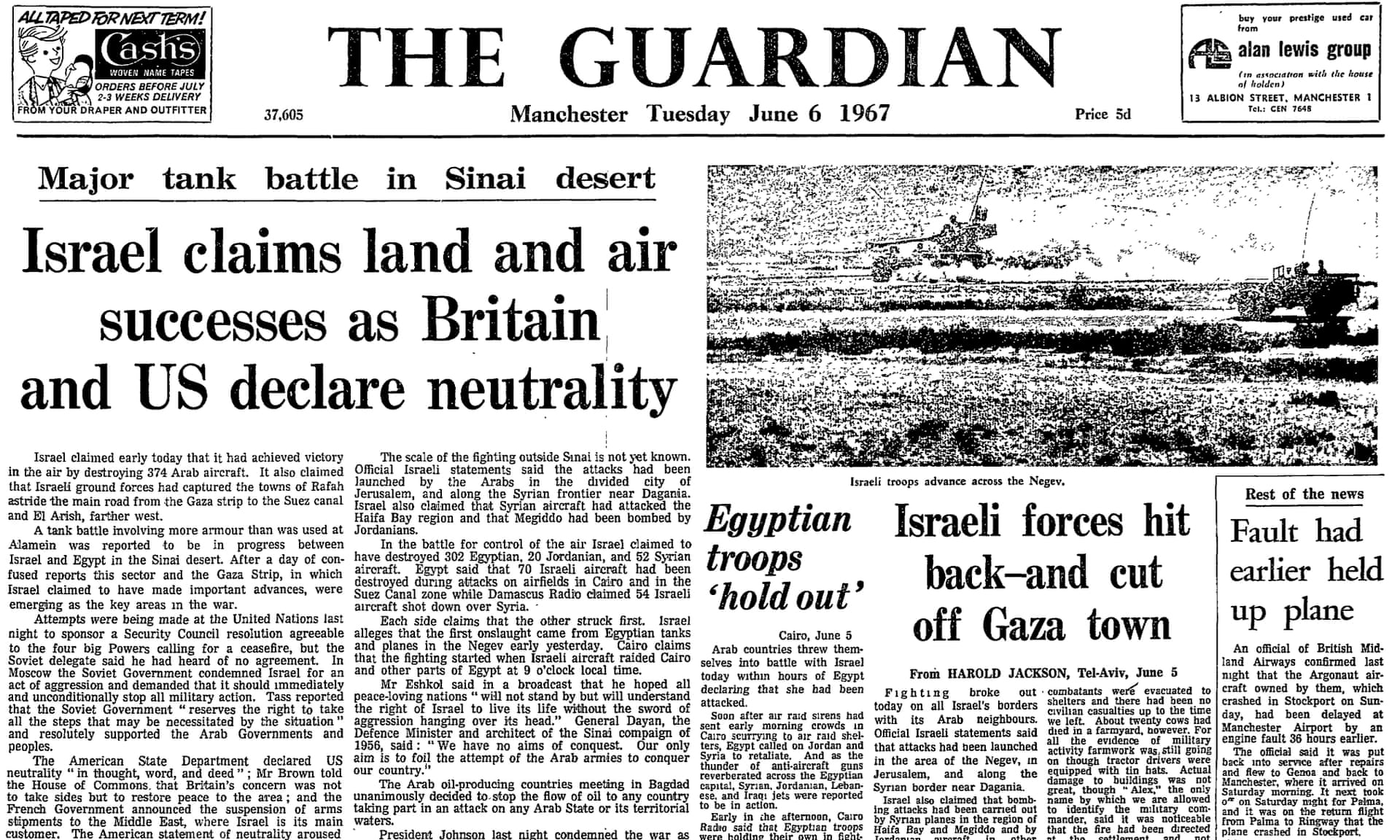 Newspaper: The Guardian, June 6th 1967. Newspaper: The Guardian, June 6th 1967.
 Map: The Jordan salient. Map: The Jordan salient. Statement to the Security Council by Abba Eban, Israel's Foreign Minister addresses UN Security Council Statement to the Security Council by Abba Eban, Israel's Foreign Minister addresses UN Security Council
I have just come from Jerusalem to tell the Security Council that Israel, by its independent effort and sacrifice, has passed from serious danger to successful resistance.
Two days ago Israel's condition caused much concern across the humane and friendly world. Israel had reached a sombre hour. Let me try to evoke the point at which our fortunes stood.
An army, greater than any force ever assembled in history in Sinai, had massed against Israel's southern frontier. Egypt had dismissed the United Nations forces which symbolized the international interest in the maintenance of peace in our region. Nasser had provocatively brought five infantry divisions and two armoured divisions up to our very gates; 80,000 men and 900 tanks were poised to move (Full Text Here).How the Arabs rallied to the support of EgyptEgypt's friends and allies threw themselves into the war, or took other measures against Israel, throughout yesterday. Some of them were: - SYRIA - An announcement was made that its aircraft were bombing Israel cities, and later it claimed to have bombed the Haifa refinery and set it ablaze. JORDAN - Its aircraft were stated to have bombed Israel territory, and its ground forces to have destroyed eight Israeli tanks near Jerusalem. LEBANON - Rashid Karami, the Prime Minister, said: "The battle has started and we are fully prepared for it." Lebanese pilots claimed to have shot down an Israel jet over central Lebanon. IRAQ - A state of war with Israel was announced, and a warning given that any state assisting Israel would be considered to be committing an act of aggression against Iraq. Iraq aircraft were said to ahve destroyed seven Israel aircraft in a raid on one base, and the Air Force claimed to have bombed Tel Aviv. SAUDI ARABIA - King Faisel sent a message of support to President Nasser and Mecca radio said that Saudi Arabian troops had entered Jordan "to fight on the side of our Arab brothers". KUWAIT - The radio broadcast a decree from Shaikh Sabah as-Salim as-Sabah, the Amir, proclaiming a "defensive war" between Kuwait and Zionist gangs in occupied Palestine." The Amir said that "the hour of asacrifice has come." SUDAN - Muhammad Mahgoub, the Prime Minister, issued a declaration of war on Israel while croweds rushing into the Constituent Assembly demanding arms. The Prime Minister said that Sudanese troops were leaving for the United Arab REpublic. The police put a guard on the American embassy while hostile demonstrators swarmed in Khartoum. ALGERIA - An army contingent was due to leave last night for the Middle East to join the battle. The Army as a whole was not on the alert. A state of war with Israel was declared. Thousands of young people stoned the American Cultural Centre in Algiers, shouting "Palestine for the Arabs". MOROCCO - King Hassan gave orders for units of the armed forces to be sent to the Middle East. YEMEN - President Abdullah al-Sallal declared the republic to be at war with Israel and declared a state of emergency. GUINEA - Conakry radio said the diplomatic relations with Israel were being severed because Israel was an instrument of international imperialism. TUNISIA - Demonstrators rampaged through the United States and British embassies in Tunis and smashed windows of Jewish shops. YouTube Day Two of the War | Six Day War Project
|
|
lordroel
Administrator
Posts: 67,964 
Likes: 49,369
|
Post by lordroel on Jun 7, 2019 7:26:53 GMT
|
|
lordroel
Administrator
Posts: 67,964 
Likes: 49,369
|
Post by lordroel on Jun 8, 2019 7:52:00 GMT
Day 4 of Six-Day War, June 8th 1967Newspapper: The Washington Post
 After a quick advancement during the night IDF soldiers reached the Suez Canal. All of the passes to the West were blocked and the Egyptian Armored forces, who attempted to reach the canal were ambushed and attacked in the Gidi and Mitleh passes. Before they escaped, the Egyptians set the Ras Sudar oil fields aflame. On the way to the canal, IDF armored forces, which were leading the forces, defeated large Egyptian Armored forces, which were attempting to pave a way to the canal. At the end of a day of battle saturated with blood, with many Armored Corps casualties, there were thousands of Egyptian soldiers who were stranded in the heart of the desert, with no access to supplies or ammunition. An Israeli battalion of tanks managed to successfully face 60 Egyptian tanks. At 21:30 the Egyptians announced their agreement to a cease- fire in the Sinai. The Major General of the Southern Command, Shayke Gavish, summarized the events: the IDF destroyed 600 tanks. 100 functioning Egyptian tanks were captured. Approximately 10,000 Egyptian soldiers were killed, and 3000 were captured. IDF losses in the Sinai: 275 dead, 800 soldiers injured, and 61 tanks were hit. Photo: Captured Egyptian soldiers bound for a prisoner of war camp pass an Israeli troop convoy in the Sinai desert.
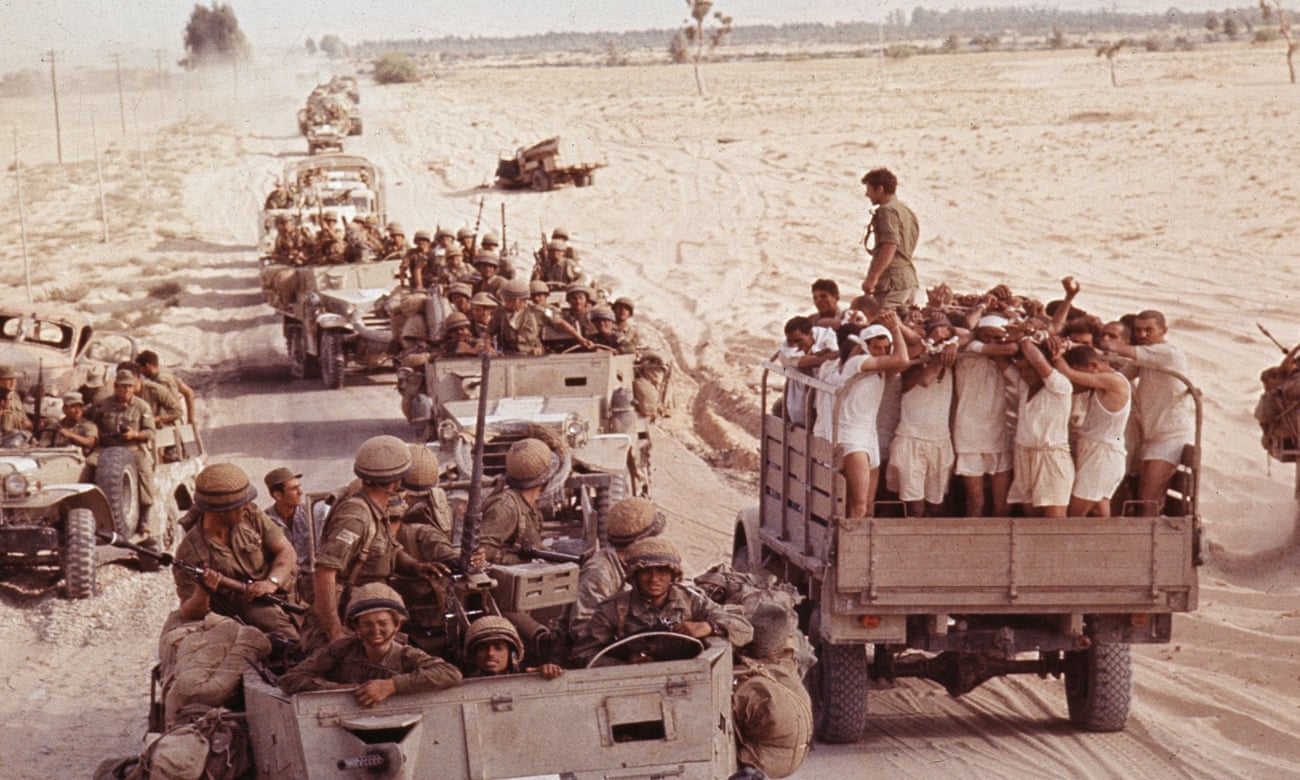 Israeli torpedo boats and planes attack and heavy damage the a United States Navy technical research ship, the USS Liberty, off the Sinai coast. Israel apologizes for the blunder, which kills 34 crew members (naval officers, seamen, two marines, and one civilian) and wounds more than 75 others. Photo: USS Liberty (AGTR-5) receives assistance from units of the U.S. Sixth Fleet, a Kaman SH-2 Seasprite helicopter of Anti-Submarine Squadron 9 (HS-9) Det.66 "Sea Griffins" is near her bow.
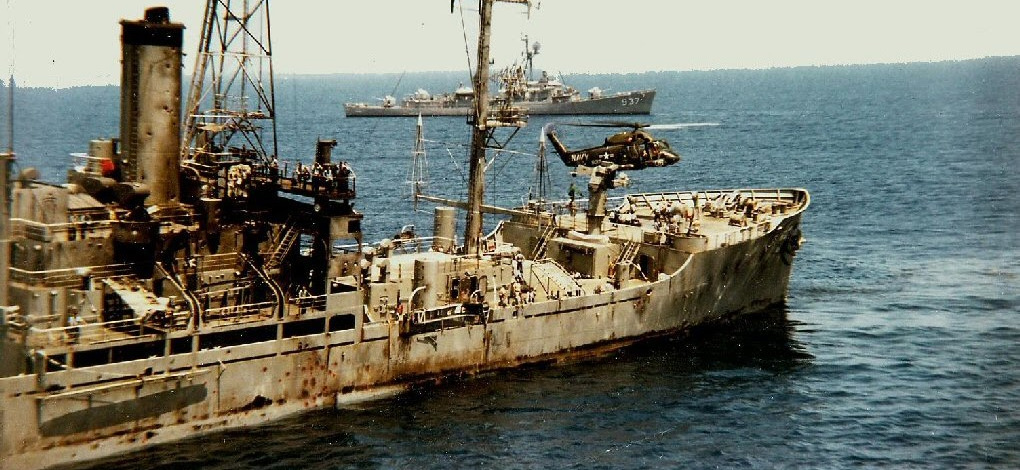 A cease-fire is declared on the Jordan-Israel front. Israeli forces are transferred from the central front to the north, where aircraft, artillery, armor and infantry break through the Syrian positions on the Golan Heights, from which Israeli villages in the valley below have repeatedly been harassed and shelled. Day Four of the War | Six Day War Project
|
|
lordroel
Administrator
Posts: 67,964 
Likes: 49,369
|
Post by lordroel on Jun 9, 2019 6:08:15 GMT
Day 5 of Six-Day War, June 9th 1967
Newspapper: The Washington Post
 U.N. The Security Council adopts a resolution that says Israel and Syria have accepted the demand for a cease-fire and demands that “hostilities should cease forthwith.” Israeli forces penetrate six to eight miles into Syria. A cease-fire is declared on the Egyptian-Israeli front. Nasser announces the Arab defeat on television, blames it on Israel’s foreign allies and says he intends to resign. “Accurate calculations were made of the enemy’s strength and showed us that our armed forces, at the level of equipment and training which they had reached, were capable of repelling the enemy and deterring him,” Nasser says. “We realized that the possibility of an armed clash existed and accepted the risk. … In the morning of last Monday, 5 June, the enemy struck. If we say now it was a stronger blow than we had expected, we must say at the same time, and with complete certainty, that it was bigger than the potential at its disposal. It became very clear from the first moment that there were other powers behind the enemy.” He says the United States and Britain were settling their accounts with the Arab national movement by helping the Jews, just as Britain had in 1956. Nasser later retracts his resignation. Map: The Battle of Golan Heights.
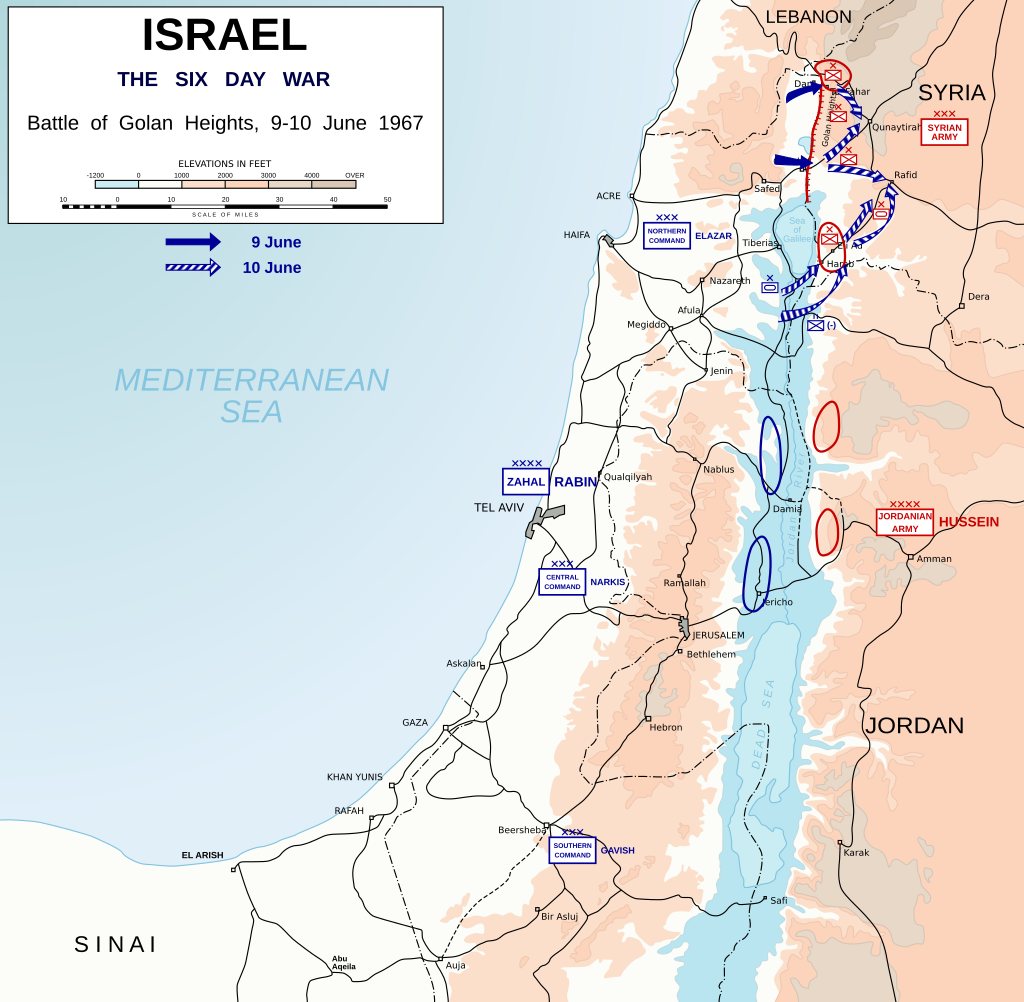 From "A Nation Under Siege" - Time Magazine Friday June 9th 1967 From "A Nation Under Siege" - Time Magazine Friday June 9th 1967
"...Only three-fourths of Israel's reserves were mobilized when war began. Now the radio read out the code names of the remaining units: Love of Zion, Close Shave, Men of Work, Alternating Current, Open Window, Good Friends. Throughout the tiny nation, youths and middle-aged men scrambled into the streets, half in uniform, half in mufti, bundles and knapsacks thrown over their shoulders as they headed for their prearranged secret rendezvous with buses. The buses used to deliver the reservists to their units in the field were often reserves too: laundry trucks, ice-cream trucks, even taxis and private cars drafted along with Israel's men and women. All were elements of a superbly organized and functioning system that Major General Dayan helped to create between 1953 and 1956 when he was Israeli Chief-of-Staff. Israeli tanks, each manned by a single regular of Israel's 50,000-man standing army, waited in convenient tank parks for the two or three reservists required to complete each crew. The tanks were ready to move out, complete with helmets, razors and toothbrushes. Each crew had been assigned battle sectors, rendezvous points and objectives. Israeli Intelligence had tracked the Arab enemy to the last desert dune. The system worked so well that Israel was able to field a fighting force of 235,000 men within 48 hours. Day Five of the War | Six Day War Project
|
|
lordroel
Administrator
Posts: 67,964 
Likes: 49,369
|
Post by lordroel on Jun 10, 2019 6:37:03 GMT
Day 6 of Six-Day War, June 10th 1967
The Israeli government offers to pay compensation for the deaths and damage in the attack on the USS Liberty. The Soviet Union breaks off diplomatic relations with Israel, as do Hungary, Bulgaria and Czechoslovakia. With the Soviet Union fearing a massive Egyptian loss, the risk of “a grave catastrophe” is compounded for the Soviets by Israel’s continued gains in the Golan Heights while fighting the Syrians. So vexed is Kosygin that he uses the hotline between Moscow and Washington to tell Johnson: “A very crucial moment has now arrived which forces us, if military actions are not stopped in the next few hours, to adopt an independence decision. We are ready to do this. However, these actions may bring us into a clash, which will lead to a grave catastrophe. Obviously, in the world there are powers to whom this would be advantageous. We propose that you demand from Israel that it unconditionally cease military action in the next few hours. On our part, we will do the same. We propose to warn Israel that, if this is not fulfilled, necessary actions will be taken, including military.” Newspapper: New York Times, June 10, 1967 (Israel's northern front)
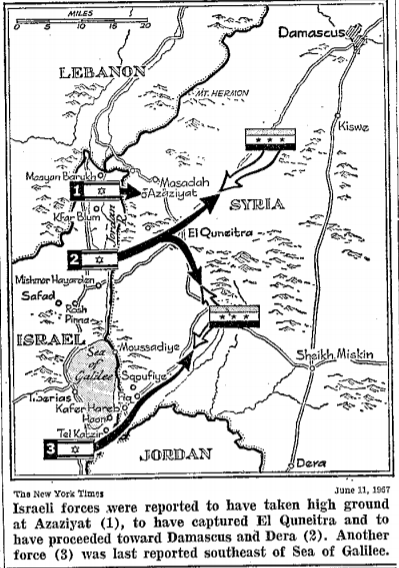 Drawing: Combined assault Golan Heights. Drawing: Combined assault Golan Heights.
 Photo: Israeli tanks advancing on the Golan Heights. Photo: Israeli tanks advancing on the Golan Heights.

Johnson tells Kosygin that the United States will press Israel for a cease-fire, and he orders the 6th Fleet, then 300 miles off the Syrian coast, to head east to within 50 miles of the coast. Johnson, in his memoir, notes that the effect of the U.S. move was to temper future Soviet actions. Israel declares victory over Syria and says it will not return to the 1949 armistice lines. Soviet U.N. representative Nikolai Federenko launches a vigorous effort to have Israel return to the pre-June lines. The Syrians agree to a cease-fire but continue to shell Israeli villages, so Israeli forces attack and occupy the whole of the Golan Heights as far as Kuneitra, less than 40 miles from Damascus. The cease-fire goes into force on the northern sector at 4:30 p.m. GMT, bringing the war to an end. Day Six of the War | Six Day War Project
|
|
lordroel
Administrator
Posts: 67,964 
Likes: 49,369
|
Post by lordroel on Jun 11, 2019 2:51:53 GMT
|
|
1bigrich
Sub-lieutenant
Posts: 478
Likes: 611
|
Post by 1bigrich on Feb 10, 2020 14:21:24 GMT
Day 4 of Six-Day War, June 8th 1967Photo: USS Liberty (AGTR-5) receives assistance from units of the U.S. Sixth Fleet, a Sikorsky SH-3A Sea King of Helicopter Anti-Submarine Squadron 9 (HS-9) Det.66 "Sea Griffins" is near her bow.
 That's a Kaman SH-2 Seasprite helicopter, not a Sea King in the photo... Regards, |
|
lordroel
Administrator
Posts: 67,964 
Likes: 49,369
|
Post by lordroel on Feb 10, 2020 14:42:42 GMT
Day 4 of Six-Day War, June 8th 1967Photo: USS Liberty (AGTR-5) receives assistance from units of the U.S. Sixth Fleet, a Sikorsky SH-3A Sea King of Helicopter Anti-Submarine Squadron 9 (HS-9) Det.66 "Sea Griffins" is near her bow.
 That's a Kaman SH-2 Seasprite helicopter, not a Sea King in the photo... Regards, Seems you are right, got it from Wikipedia, where it seems all the pictures related to this scene describe the helicopter hovering above the USS Liberty as a Sikorsky SH-3A Sea King. |
|





























